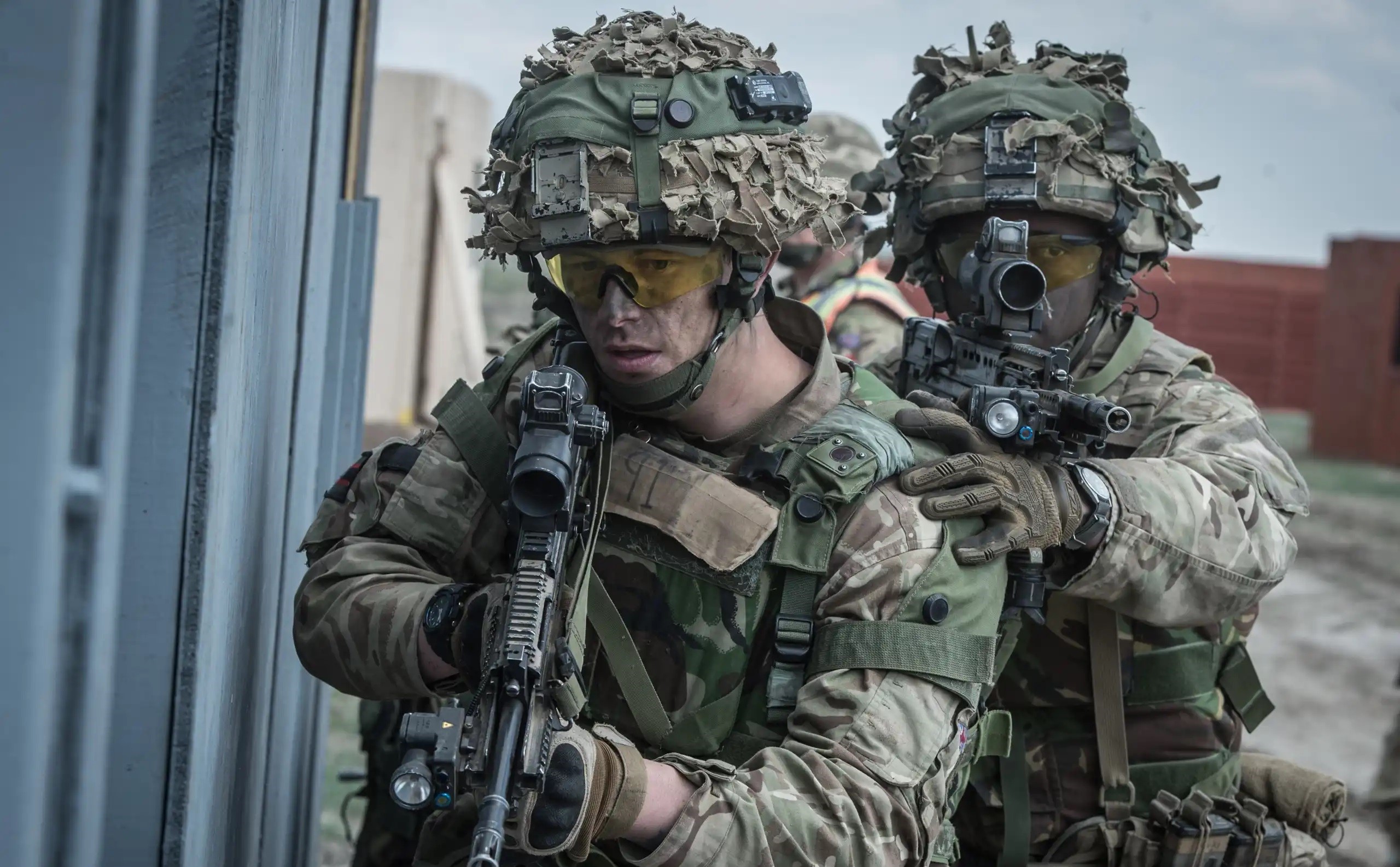daftandbarmy
Army.ca Fossil
- Reaction score
- 43,014
- Points
- 1,160
No, not a Cold War movie...
Underwater infrastructure, not underground...
Underwater infrastructure, not underground...

No, not a Cold War movie...
Underwater infrastructure, not underground...
 nationalsecuritynews.com
nationalsecuritynews.com
I can't help myself. Every time I see an article by a former soldier which laments the decrease in size of the regular army, I cringe. The size of the regular army has only a partial impact at the capability and staying power of an army. What needs to be included and discussed and debated just as much , if not more, is the size and equipment capability of the reserves.The British Army’s regular force now stands at a mere 72,000 soldiers, the smallest it has been since the mid-Eighteenth Century.
I should say so, that dressing's abominable
The British Army is in serious trouble. How did this happen and what can be done about it? Guest writer Colonel (retd) Harry Fullerton OBE gives his view.
The British Army’s regular force now stands at a mere 72,000 soldiers, the smallest it has been since the mid-Eighteenth Century. Whilst it is still a much respected organisation that continues to deliver incredible outputs, it must now contend with the new Labour Government’s Strategic Defence Review (SDR 2025), which will be looking for further ways to deliver the UK’s mandated defence outputs for less. Regular Army soldier numbers should not be the only factor in deciding how the Land Force should be structured, however they do constrain what tasks and outputs the Army are instructed to achieve. And today’s small number of regular troops appears contrary to the current global instability caused by the Russian invasion of Ukraine, as well tension and conflicts in the Middle East and beyond. It worries the UK’s allies across NATO, but especially in the US. An independent report issued in 2024 by New Bletchley is a clear warning that the UK is running huge risks by ignoring the ever weakening capability of the British Army.
In 2021, the previous Government’s Security Defence Review (SDR) dealt an uncomfortable blow to the British Army. The Army was reduced from a regular force of some 82,000 to 72,000. Regiments became smaller and more niche in their roles. The Army reduced from two warfighting (armoured or mechanised) divisions to just one. Equipment capabilities were cut and a new era of ‘light, expeditionary and agile’ was announced. Back in 2021, this almost seemed like a plausible concept for the future Land Force to many optimists. A return to armoured warfare (i.e. the mass use of tanks and heavy artillery) anywhere in the world, let alone in Europe, appeared highly unlikely. Yet just a year later, President Putin invaded Ukraine (for the second time) and suddenly all bets were off.
Warfighting
The British Army has retained, in theory, the ability to deploy and operate as a warfighting armoured division. However, it is obvious to most in the profession that the British Army’s core capability of armoured warfare had been diluted to a point where it would be difficult to deploy now with the kind of capability that it promises to deliver. It is not just tank numbers that have ben cut in successive SDRs (which will always grab the headlines), but all the essential combat support such as armoured engineers, bridging assets, equipment support, communications and logistics that also took hit after hit, and cutback after cutback. Over the years, a catchy phrase called ‘frontline first’ has tried to cover over the cuts to all the combat support and support capabilities. It is an easy image to portray in peacetime but it falls apart very quickly when that same armoured division needs to deploy in short order, and then be sustained on combat operations for possibly many months. Given these changes and cuts to the British Army, it becomes harder to convince NATO allies, especially the US, that the British Army is still capable of deploying and operating at the sort of scale an armoured division brings with it. There is one thing worse for an army than not having a desired warfighting capability, and that is pretending that you have one. And that is where the British Army finds itself today. How did this happen? When did it happen? What caused it? And what, if anything, can be done about it?
The British Army is in serious trouble. How did this happen and what can be done about it? Guest writer Colonel (retd) Harry Fullerton OBE gives his view. – National Security News
British Army Recruits. (Source - Ministry of Defence (MOD)). The British Army’s regular force now stands at a mere 72,000 soldiers, the smallest it has been since the mid-Eighteenth Century. Whilst it is still a much respected organisation that continues to deliver incredible outputs, it must...nationalsecuritynews.com
I should say so, that dressing's abominable
The British Army is in serious trouble. How did this happen and what can be done about it? Guest writer Colonel (retd) Harry Fullerton OBE gives his view.
The British Army’s regular force now stands at a mere 72,000 soldiers, the smallest it has been since the mid-Eighteenth Century. Whilst it is still a much respected organisation that continues to deliver incredible outputs, it must now contend with the new Labour Government’s Strategic Defence Review (SDR 2025), which will be looking for further ways to deliver the UK’s mandated defence outputs for less. Regular Army soldier numbers should not be the only factor in deciding how the Land Force should be structured, however they do constrain what tasks and outputs the Army are instructed to achieve. And today’s small number of regular troops appears contrary to the current global instability caused by the Russian invasion of Ukraine, as well tension and conflicts in the Middle East and beyond. It worries the UK’s allies across NATO, but especially in the US. An independent report issued in 2024 by New Bletchley is a clear warning that the UK is running huge risks by ignoring the ever weakening capability of the British Army.
In 2021, the previous Government’s Security Defence Review (SDR) dealt an uncomfortable blow to the British Army. The Army was reduced from a regular force of some 82,000 to 72,000. Regiments became smaller and more niche in their roles. The Army reduced from two warfighting (armoured or mechanised) divisions to just one. Equipment capabilities were cut and a new era of ‘light, expeditionary and agile’ was announced. Back in 2021, this almost seemed like a plausible concept for the future Land Force to many optimists. A return to armoured warfare (i.e. the mass use of tanks and heavy artillery) anywhere in the world, let alone in Europe, appeared highly unlikely. Yet just a year later, President Putin invaded Ukraine (for the second time) and suddenly all bets were off.
Warfighting
The British Army has retained, in theory, the ability to deploy and operate as a warfighting armoured division. However, it is obvious to most in the profession that the British Army’s core capability of armoured warfare had been diluted to a point where it would be difficult to deploy now with the kind of capability that it promises to deliver. It is not just tank numbers that have ben cut in successive SDRs (which will always grab the headlines), but all the essential combat support such as armoured engineers, bridging assets, equipment support, communications and logistics that also took hit after hit, and cutback after cutback. Over the years, a catchy phrase called ‘frontline first’ has tried to cover over the cuts to all the combat support and support capabilities. It is an easy image to portray in peacetime but it falls apart very quickly when that same armoured division needs to deploy in short order, and then be sustained on combat operations for possibly many months. Given these changes and cuts to the British Army, it becomes harder to convince NATO allies, especially the US, that the British Army is still capable of deploying and operating at the sort of scale an armoured division brings with it. There is one thing worse for an army than not having a desired warfighting capability, and that is pretending that you have one. And that is where the British Army finds itself today. How did this happen? When did it happen? What caused it? And what, if anything, can be done about it?
The British Army is in serious trouble. How did this happen and what can be done about it? Guest writer Colonel (retd) Harry Fullerton OBE gives his view. – National Security News
British Army Recruits. (Source - Ministry of Defence (MOD)). The British Army’s regular force now stands at a mere 72,000 soldiers, the smallest it has been since the mid-Eighteenth Century. Whilst it is still a much respected organisation that continues to deliver incredible outputs, it must...nationalsecuritynews.com


 www.msh-usv.it
www.msh-usv.it
Pick two.Quality British Engineering
Looks like the British have found their new Saxon


 thedefensepost.com
thedefensepost.com
Bloody Hell its Ivan!! Nice ship old chap!!! It would be awful if it were to hit something don't you think old boy?No, not a Cold War movie...
Underwater infrastructure, not underground...

What a crock of shit: Who ruled that? Sinn Finn representatives?Of course, poor underprivileged IRA waifs...
SAS 'not justified' in 1992 shooting of four IRA men
The use of lethal force by SAS soldiers was unjustified when they opened fire killing four IRA men in an ambush at Clonoe in County Tyrone, an inquest has ruled.
Kevin Barry O'Donnell, 21, Sean O'Farrell, 22, Peter Clancy, 21, and Patrick Vincent, 20, died in February 1992, minutes after they had carried out a gun attack on Coalisland police station.
The soldiers opened fire as the men arrived at St Patrick's Church car park in a hijacked lorry which had a heavy machine gun welded to its tailgate.
Security forces had intelligence the car park would be used and 12 soldiers were in position behind a hedgerow.
Advertisement
In response to the ruling, Downing Street said "addressing the issues of the past must be done in a way that commands the support of families, survivors and, importantly, the families of those killed serving the state".
A spokesperson added that "any veteran who served during the Troubles is provided legal support where appropriate".

SAS: 1992 shooting of IRA men was 'unjustified' says inquest
The use of lethal force by SAS soldiers was unjustified when they opened fire, inquest rules.www.bbc.com
What a crock of shit: Who ruled that? Sinn Finn representatives?
Whoever it was needs a swift hard kick to.....

Of course, poor underprivileged IRA waifs...
SAS 'not justified' in 1992 shooting of four IRA men
The use of lethal force by SAS soldiers was unjustified when they opened fire killing four IRA men in an ambush at Clonoe in County Tyrone, an inquest has ruled.
Kevin Barry O'Donnell, 21, Sean O'Farrell, 22, Peter Clancy, 21, and Patrick Vincent, 20, died in February 1992, minutes after they had carried out a gun attack on Coalisland police station.
The soldiers opened fire as the men arrived at St Patrick's Church car park in a hijacked lorry which had a heavy machine gun welded to its tailgate.
Security forces had intelligence the car park would be used and 12 soldiers were in position behind a hedgerow.
In response to the ruling, Downing Street said "addressing the issues of the past must be done in a way that commands the support of families, survivors and, importantly, the families of those killed serving the state".
A spokesperson added that "any veteran who served during the Troubles is provided legal support where appropriate".

SAS: 1992 shooting of IRA men was 'unjustified' says inquest
The use of lethal force by SAS soldiers was unjustified when they opened fire, inquest rules.www.bbc.com
What a crock of shit: Who ruled that? Sinn Finn representatives?
Whoever it was needs a swift hard kick to.....


